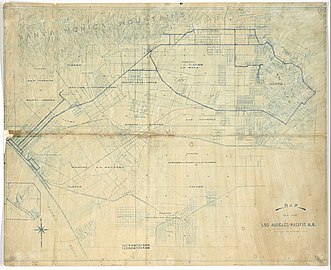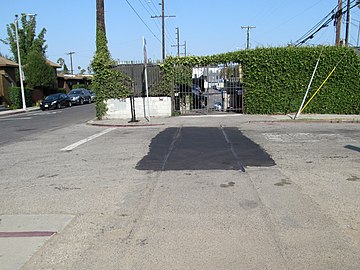-
California Central Railway - Santa Fe 1888 route map including Redondo Junction to Port Ballona
-
Los Angeles-Pacific R.R. featuring the "Inglewood Division…steam line bought of Southern California Ry. Co. (map c. 1900)
-
Venice–Inglewood was part of the celebrated Balloon Route c. 1905
-
Mesmer City was a proposed (but never developed) subdivision for the Mesmer stop of the Venice–Inglewood Line (map circa 1924)
-
Former tracks of the Inglewood Line on Venice's Broadway Street, next to Electric Avenue
-
Venice–Inglewood tracks crossing Lincoln Blvd. toward Marina Del Rey
-
Venice–Inglewood line at the Alla wye; the Redondo Beach via Playa del Rey berm is behind the fence on the left
-
Rail bridge pylons remaining from Ballona Creek crossing of Venice–Inglewood Line; 90 freeway to the rear
-
An auto ramp entering the former Inglewood–Venice freight train tunnel/lane along Centinela Avenue, under the 405 freeway
| Venice–Inglewood | ||||||||||||||||||||||||||||||||||||||||||||||||||||||||||||||||||||||||||||||||||||||||||||||||||||||||
|---|---|---|---|---|---|---|---|---|---|---|---|---|---|---|---|---|---|---|---|---|---|---|---|---|---|---|---|---|---|---|---|---|---|---|---|---|---|---|---|---|---|---|---|---|---|---|---|---|---|---|---|---|---|---|---|---|---|---|---|---|---|---|---|---|---|---|---|---|---|---|---|---|---|---|---|---|---|---|---|---|---|---|---|---|---|---|---|---|---|---|---|---|---|---|---|---|---|---|---|---|---|---|---|---|
 | ||||||||||||||||||||||||||||||||||||||||||||||||||||||||||||||||||||||||||||||||||||||||||||||||||||||||
| Overview | ||||||||||||||||||||||||||||||||||||||||||||||||||||||||||||||||||||||||||||||||||||||||||||||||||||||||
| Locale | Los Angeles County, California | |||||||||||||||||||||||||||||||||||||||||||||||||||||||||||||||||||||||||||||||||||||||||||||||||||||||
| Termini | ||||||||||||||||||||||||||||||||||||||||||||||||||||||||||||||||||||||||||||||||||||||||||||||||||||||||
| Service | ||||||||||||||||||||||||||||||||||||||||||||||||||||||||||||||||||||||||||||||||||||||||||||||||||||||||
| Type | Interurban | |||||||||||||||||||||||||||||||||||||||||||||||||||||||||||||||||||||||||||||||||||||||||||||||||||||||
| System | Pacific Electric | |||||||||||||||||||||||||||||||||||||||||||||||||||||||||||||||||||||||||||||||||||||||||||||||||||||||
| Operator(s) | Pacific Electric | |||||||||||||||||||||||||||||||||||||||||||||||||||||||||||||||||||||||||||||||||||||||||||||||||||||||
| Daily ridership | <1 (1927) | |||||||||||||||||||||||||||||||||||||||||||||||||||||||||||||||||||||||||||||||||||||||||||||||||||||||
| History | ||||||||||||||||||||||||||||||||||||||||||||||||||||||||||||||||||||||||||||||||||||||||||||||||||||||||
| Opened | c. October 18, 1902 (under Los Angeles Pacific Railroad) | |||||||||||||||||||||||||||||||||||||||||||||||||||||||||||||||||||||||||||||||||||||||||||||||||||||||
| Closed | September 13, 1928 | |||||||||||||||||||||||||||||||||||||||||||||||||||||||||||||||||||||||||||||||||||||||||||||||||||||||
| Technical | ||||||||||||||||||||||||||||||||||||||||||||||||||||||||||||||||||||||||||||||||||||||||||||||||||||||||
| Line length | 9.056 mi (14.574 km) | |||||||||||||||||||||||||||||||||||||||||||||||||||||||||||||||||||||||||||||||||||||||||||||||||||||||
| Track gauge | 1,435 mm (4 ft 8+1⁄2 in) standard gauge | |||||||||||||||||||||||||||||||||||||||||||||||||||||||||||||||||||||||||||||||||||||||||||||||||||||||
| Electrification | 600 V DC Overhead lines | |||||||||||||||||||||||||||||||||||||||||||||||||||||||||||||||||||||||||||||||||||||||||||||||||||||||
| ||||||||||||||||||||||||||||||||||||||||||||||||||||||||||||||||||||||||||||||||||||||||||||||||||||||||
The Venice–Inglewood Line is a former Pacific Electric interurban railway line in Los Angeles County, California. Service was very sparse, providing a suburban route between Venice and Inglewood.
History
California Central
The branch line was built by the Atchison, Topeka and Santa Fe Railway, [2] [3] opening in June 1887 from Inglewood to Port Ballona (on the site of today’s Playa del Rey).
Los Angeles and Santa Monica Railroad was incorporated on January 6, 1886, to build a railroad line from downtown Los Angeles to a depot on the Santa Monica Bay in Los Angeles County. In March 1886, the Los Angeles Herald reported that the " surveyors of the Santa Monica Railroad have just crossed the S.P. track at Ballona, just where the county road crossed that track near La Ballona station. The terminus is finally fixed at South Santa Monica, near where the old Juan Bernard wharf is." [4]
California Central Railway purchased the Los Angeles and Santa Monica Railroad, but the Los Angeles and Santa Monica Railroad company had not started any work on any rail lines, California Central Railway did get needed right of way land. The 18.03 mi (29.02 km) line was opened for business on September 7, 1887, with stops (from northeast to southwest) at Ballona Junction, Nadeau Park, Baldwin, Slauson, Wildeson, Hyde Park, Inglewood, Danville, Mesmer, and Port Ballona. A train left Los Angeles at 9:15 a.m. on the one-hour journey and returned from Port Ballona at 4 p.m. [5]Santa Fe and Santa Monica
The oceanside terminal was moved to Ocean Park, under the April 4, 1892 charter of the Santa Fe and Santa Monica "to build from a point at or near ' Mesmer Station' on line of Southern California Railway Company between Inglewood and Ballona, Los Angeles County, to Town of Santa Monica." [6]
Los Angeles Pacific & Pacific Electric
The route was acquired by the Los Angeles Pacific Railroad on March 21, 1902, [6] [7] and was shortly after electrified for service by that October. Service was limited to a single daily car. [8] After Pacific Electric absorbed the company in 1911, service consisted of a single round trip mixed train (combined passenger and freight) daily except Sunday, when additional trains were run. Passenger trips ended after September 13, 1928. [9]
Southern Pacific
According to Abandoned Rails, “The line also served produce warehouses and other small businesses until the 1960s. Under the ownership of the Southern Pacific, most of the rails remained in place until 1977.” [10] In 1976, Southern Pacific applied to abandon the track past Alla through Machado to Venice. [11]
All tracks along the route had been removed or paved over by 1981. Though much of the right-of-way has been built over, most of it has not been merged with neighboring parcels. The former route can be traced through a series of oddly-shaped, narrow structures, parking lots, and strips of vacant land. The former embankment can still be seen along the south side of Rogers Park in Inglewood.
Depot

Inglewood Depot was built in 1887 and survived until the 1970s when it was demolished following an arson fire.
Route
The Venice–Inglewood Line was a single-track line in a private right of way. The line originated at the Pacific Electric Inglewood station and the Atchison, Topeka and Santa Fe Railway junction at Ivy Avenue and Ballona Street in Inglewood. [12]
From the station, the line ran westerly and northwesterly following intermittent sections of Ballona Street, Hyde Park Boulevard and Thorneburn Street while crossing La Cienega Boulevard at-grade and passing under La Tijera Boulevard. The section of right-of-way from La Cienega to Centinela remains as a vacant strip parallel to the Centinela Creek flood control channel, with the undercrossing beneath La Tijera still visible. The section east of La Cienega has been partially developed with a storage facility, but continues along the north side of Oak street as an empty strip planted with trees and grass. [12]
Continuing northwesterly, the line ran approximately one-half mile (0.8 km) before paralleling Centinela Avenue (on the south) and crossing Sepulveda Boulevard at-grade. Following Centinela Avenue, the single track line curved westerly and southwesterly to run between Centinela and the Hughes Airport. The line ran between the runaways and the south side of Centinela– Jefferson Boulevard. It then crossed Jefferson Boulevard to head northwesterly and cross Ballona Creek. Nothing remains of most of this section, as the Hughes Airport was redeveloped into the Playa Vista neighborhood. However a small portion of the right-of-way remains on the south side of Centinela just west of Sepulveda, as a derelict strip of dirt that interrupts the sidewalk, and support columns for the crossing are still visible in Ballona Creek. [12]
The Venice–Inglewood Line continued northwesterly from Ballona Creek crossing Culver Boulevard and the adjacent Redondo Beach via Playa del Rey Line at-grade to Alla Wye. It then ran adjacent to California State Route 90 on a separate right of way which remains vacant. Next, the track crossed Lincoln Boulevard (where a small section of track is still visible) and ran northwesterly to follow intermittent sections of Oxford Avenue while crossing Washington Street and then Washington Boulevard. This portion of track was subdivided for residential development, creating a long row of unusually small, narrow houses along Oxford Avenue. [12]
The line then crossed Venice Boulevard (with the Venice Short Line) and continued northwesterly following the west side of Electric Avenue through Venice to cross Main Street and reach the terminus of the line at the Ocean Park Carhouse (west of Main Street between Paloma and Thornton Avenues in Venice, a site which would later house a Metro bus yard). [12] Another source mentions a Santa Monica terminus at 5th Avenue (and Electric). [13] The distance covered by the Venice–Inglewood route was 9.056 miles (14.574 km). [13]
Ridership
While the Santa Fe experienced strong initial ridership on the line, declining passenger loads contributed to the company's decision to sell the route. [8] A survey by the California Railroad Commission for the week ending September 3, 1927 revealed that a single passenger had ridden the line in the time period; eight trips were made the entire month. [9]
Gallery
References
- ^ Pacific Electric station, Inglewood (~1937), retrieved October 20, 2022 – via Los Angeles Public Library Photo Collection
- ^ Schwieterman, Joseph P. (2004). When the Railroad Leaves Town. Kirksville, MO: Truman State University Press. pp. 75–79. ISBN 9781931112130.
- ^ Hilton, George W.; Due, John F. (2000) [1960]. The Electric Interurban Railways in America. Stanford, California: Stanford University Press. p. 412. ISBN 0-8047-4014-3.
- ^ "Los Angeles Herald 14 Mar 1886, page Page 1". Newspapers.com. Retrieved March 11, 2023.
- ^ "Opening of the Ballona Branch". Los Angeles Herald. September 8, 1887. p. 10. Retrieved March 12, 2023 – via California Digital Newspaper Collection.
- ^
a
b Holterhoff, G. (1914).
Historical review of the Atchison, Topeka and Santa Fe Railway Company (with particular reference to California lines) as furnished to the Railroad Commission of the state of California in compliance with its General order no. 38. Los Angeles.
{{ cite book}}: CS1 maint: location missing publisher ( link) ( Alternate link) -
^
"Railroad transfer at Santa Monica". The Los Angeles Times. March 25, 1902. p. 17. Retrieved December 14, 2022 – via Newspapers.com.

- ^ a b "Inglewood Line". Electric Railway Historical Association of Southern California. Archived from the original on February 27, 2021. Retrieved January 19, 2021.
- ^ a b Veysey, Laurence R. (June 1958). A History Of The Rail Passenger Service Operated By The Pacific Electric Railway Company Since 1911 And By Its Successors Since 1953 (PDF). LACMTA (Report). Los Angeles, California: Interurbans. pp. 22, 117. ASIN B0007F8D84. OCLC 6565577.
- ^ "The Inglewood Branch - Abandoned Rails". www.abandonedrails.com. Archived from the original on October 23, 2021. Retrieved September 26, 2022.
- ^ United States (1976). Southern Pacific Transportation Company abandonment between Alla and Venice, ETAS: environmental impact statement.
- ^ a b c d e California Department of Transportation. 1981 Inventory of Pacific Electric Routes (PDF) (pdf). State of California – via LACMTA.
- ^
a
b
"Railroad and Trolley Linking Santa Monica to Inglewood". Los Angeles Times. September 16, 1981. pp. 2–m1 – via Newspapers.com. (
Second Part)

External links
Photos
- LAPL photo collection: Electric trolley "Inglewood only" - jobs for GIs
- Color photos of a Red Car on the Venice–Inglewood line, possibly 1940s
- Inglewood train station 1969
- Electric Train Arriving Venice 1911
- One Week (1920) - Additional footage of station train on track on YouTube
- Pacific Electric routes
- Light rail in California
- Railway lines opened in 1887
- 1887 establishments in California
- Railway services discontinued in 1928
- 1928 disestablishments in California
- Closed railway lines in the United States
- Inglewood, California
- Playa Vista, Los Angeles
- Marina del Rey, California
- Venice, Los Angeles
- Westside (Los Angeles County)
- Ballona Creek
- Atchison, Topeka and Santa Fe Railway lines









